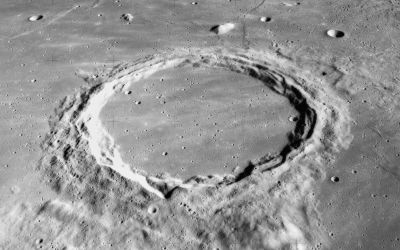Archimedes
Contents
Archimedes
|
Lat: 29.71°N, Long: 3.99°W, Diam: 81.04 km, Depth: 1.6 km, Rükl: 22, Upper Imbrian |
Images
LPOD Photo Gallery Lunar Orbiter Images Apollo Images Kaguya Image, looking south
- On pages 250 and 251 of the article To The Mountains Of The Moon (the story of Apollo 15) by Kenneth F. Weaver (National Geographic, february 1972) there's an impressive mosaic of five orbital ITEK-panoramic frames which show a northward-looking oblique close up view of Archimedes (and Montes Archimedes south of it).
These five ITEK-frames are:
AS15-P-9395 (the eastern part of Archimedes's rim and outer sunlit slopes, partially shadowed floor).
AS15-P-9397
AS15-P-9399 (the central part of Archimedes's floor, with large amount of craterlets).
AS15-P-9401
AS15-P-9403 (the western part of Archimedes's rim and sunlit inner slopes).
All five frames are part of: Revolution 16 - Aft Facing Camera.
Research Apollo 15's orbital ITEK-panoramic frames: Danny Caes
Maps
(LAC zone 41A2) LAC map Geologic map LM map
Description
Here is an experimental audio file (1:12 minute) of me talking about Archimedes.Elger
(IAU Directions) ARCHIMEDES.--Next to Plato the finest object on the Mare Imbrium. It is about 50 miles in diameter. The average height of its massive border is about 4,000 feet above the interior, which is only depressed some 500 or 600 feet below the Mare, the highest peak (about 7,000 feet) being on the S.W. The walls are terraced, and include much detail, both within and without. The most noteworthy features in connection with this formation are the crater-cones, craterlets, pits, white spots, and light streaks which figure on the otherwise smooth interior. Mr. T.P. Gray, F.R.A.S., of Bedford, who, with praiseworthy assiduity, has devoted more than ten years to the close scrutiny of these features, Mr. Stanley Williams, and others, have detected four crater-cones on the W. half of the floor, and about fifty minute craters and white spots, also probably volcanic vents, and a very curious and interesting series of light streaks, mostly traversing the formation from W. to E. A little W. of the ce
ntre is a dusky oval area about 6 miles across, and S.E. of this is another, much smaller. Under some conditions of illumination the two principal light markings may be traced over the E. wall, and for some distance on the plain beyond.
On the southern side of Archimedes is a very rugged mountain region, extending for more than 100 miles towards the south: on the E. of this originates a remarkable rill-system, best seen under evening illumination. The two principal clefts follow a nearly parallel course up to the face of the Apennines near Mount Bradley, crossing in their way, almost at right angles, other clefts which run at no great distance from the W. foot of this range and ramify among the outlying hills. Archimedes A is a brilliant little ring-plain on the S.W. of Archimedes. It casts an extraordinary shadow at sunrise, and has a well-marked crater-row on the W. of it, and two long narrow valleys, one of which appears to be a southerly extension of the row.
Wikipedia
Additional Information
- IAU page: Archimedes
- Depth data from Kurt Fisher database
- Pike, 1976: 1.6 km
- Westfall, 2000: 1.6 km
- Viscardy, 1985: 2.15 km
- Cherrington, 1969: 2.07 km
- Small pyroclastic deposit (area = 8 km^2) on S rim. Gaddis, L. (1999) Lunar Pyroclastic Volcanism Project.
- Archimedes F concentric crater
- Archimedes A is a thermal anomaly crater, implying youthful age - Moore et al, 1980
Nomenclature
- Archimedes of Syracuse (c. 287 BC – c. 212 BC) was an ancient Greek mathematician, physicist and engineer. Although little is known about his life, he is regarded as one of the most important scientists in classical antiquity.
- The region immediately west of Archimedes was called Lacus Marinus on J.Hewelcke's map (or was it perhaps the floor of Archimedes?). J.Hewelcke's name for the whole of the IAU's Archimedes was Mons Argentarius (or was it only the ring of mountains surrounding Lacus Marinus?). Ewen A. Whitaker's location of J.Hewelcke's Lacus Marinus ("western corner of Mare Imbrium") is wrong.- DannyCaes Apr 23, 2016
LROC Articles
LPOD Articles
- 1.5 Billion Years of History.
- Archimedes and his Mountains
- Three Cheers for Three As
- No Fooling
- Elevated Drapery (Kaguya image).
Lunar 100
- L27: Large crater lacking central peak.
Bibliography
Wood, C.A. Jan. 2001. Archimedes, Autolycus, Aristillus, and time. S&T Jan 2001 v101 p137
Apollo Over the Moon, Chapter 5: Craters (Part 6), Figure 179.
Named Features -- Prev: Promontorium Archerusia -- Next: Montes Archimedes
